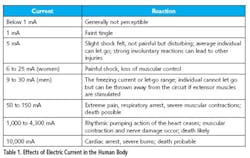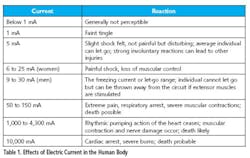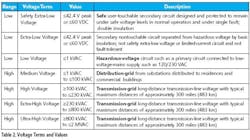The Why, When, and How of Electrical Safety Testing
Electrical safety testing has been around for almost a century, and safety agencies have been testing and certifying products for almost as long. Electrical and electronic products have changed dramatically over the years, requiring the safety standards to evolve to accommodate the changes in technology.
Not all consumers and manufacturers fully understand the reasons for and importance of proper electrical safety testing. Shock hazards vary in severity and range from a tingling sensation to a lethal jolt. Identifying, correcting, and eliminating shock hazards are the primary reasons for electrical safety testing.
The equipment used to certify and verify a product’s electrical safety also has changed over time. The technology has improved the performance, accuracy, reliability, operator protection, and data capture of test results and critical product information. The improvements to the test equipment make safety testing simpler and more efficient for the manufacturer.
Why Do We Need Electrical Safety Testing?
The obvious answer is consumer and operator protection from shock hazards. Shock hazards exist when a voltage and current are accessible to the operator with respect to earth ground.
According to OSHA’s Publication 3075, a shock hazard is considered to exist at an accessible part in a circuit between the part and ground or other accessible parts if the potential is more than 42.4 V peak and the current through a 1,500-? load is more than 5 mA.
Studies have concluded that the human body can feel the sensation of an electrical shock with as little as 1.0 mA of current. Since the human body is not a fixed resistance, the voltage required to produce 1.0 mA of current can vary greatly based on the minimum impedance of the human body under various conditions. Some models use a human body resistance value of 1 k? to 100 k?. Table 1 details the effects of electrical current in the human body.1
Many types of consumer electronics are battery powered and operate at safety extra-low voltages which are not considered a shock hazard to the consumer. However, the chargers for these batteries plug into the wall and have the voltage and current to be a hazard. As a result, they need testing for electrical safety compliance.
Consider your cell phone. Most of the time it presents no shock hazard to you. However, when you plug it into the charger and connect the charger to a wall outlet, you now have a possible shock hazard. If the insulation between the charger and your phone were to fail, the primary voltage applied to the charger could be present on conductive surfaces to which you have access.
Table 2 shows voltage levels from various sources compiled by David Lohbeck of National Instruments (EDN, May 11, 2006). Most safety standards use the voltage terminology listed in the table. Safety extra-low voltage is the only condition that is not considered a shock hazard.
When Is Safety Testing Required?
Safety testing is required at the point of manufacture, before the product is available to the end user. Manufacturers of electrical and electronic products must ensure that no hazardous voltages or currents are accessible to the user. They need to test their products to determine if they meet minimum safety levels.
To address this issue, safety agencies and panels of consumer advocates and manufacturers have developed electrical safety standards. These standards ensure that properly designed and constructed products will be electrically safe. They identify types of equipment and the possible shock hazards from each, the minimum requirements for protecting the operator from high voltage and leakage currents, and test methods that determine if the product’s insulation system meets the minimum requirements. There also is the issue of design conformity and liability of the manufacturer.
Agencies such as Underwriters Laboratories (UL), the Canadian Safety Association (CSA), and Technischer Überwachungsverein (TUV) test and certify that electrical and electronic equipment is safe to operate. Once these products are tested and proven to comply with the appropriate standard, the agency will allow the manufacturer to place a label on the unit to signify compliance or certification. These labels give consumers confidence in their equipment and confirm that the manufacturer has certified and verified the product for electrical safety.
These agencies not only test and certify the product based on a few sample units, they also routinely inspect the product at the manufacturer’s facility to ensure it continues to meet the requirements whether they are building one unit or millions of units.
The manufacturer’s liability rests on conformance. The manufacturer must ensure conformance by testing 100% of the products it produces. Proof of compliance, including records of tests performed, is required to comply with safety agency standards.
The manufacturer must maintain accurate records to ensure it builds products with the same materials and processes on a continuous basis. The manufacturer must notify the safety agency of any changes to the material, design, or process used in producing its product. If the manufacturer makes a change, safety agencies may amend the safety certification; in some cases, the product may need to be recertified.
Several More Common Standards
• UL 60335-1 and IEC 60335-1: Safety of Household and Similar Electrical Appliances
“This international standard deals with the safety of electrical appliances for household and similar purposes, their RATED VOLTAGE being not more than 250 V for single-phase appliances and 480 V for other appliances. Appliances not intended for normal household use but which nevertheless may be a source of danger to the public, such as appliances intended to be used by laymen in shops, in light industry, and on farms, are within the scope of this standard. Examples of such appliances are catering equipment, cleaning appliances for industrial and commercial use, and appliances for hairdressers. As far as is practicable, this standard deals with the common hazards presented by appliances that are encountered by all persons in and around the home.”
Almost everyone in the United States encounters some type of household appliance multiple times per day. These appliances consist of ovens, refrigerators, toasters, coffee makers, juicers, washers and dryers, and more. To ensure the safety of users, all of these products should be electrical safety tested.
• UL60950 and IEC60950-1: General Requirements for Safety of Information Technology Equipment (ITE)
“This standard is applicable to mains-powered or battery-powered information technology equipment, including electrical business equipment and associated equipment, with a RATED VOLTAGE not exceeding 600 V and designed to be installed in accordance with the Canadian Electrical Code, Part I, CSA C22.1; CSA C22.2 No. 0; the National Electrical Code, NFPA 70; and the National Electrical Safety Code, IEEE C2.”
ITE is one of the most commonly used types of products available today. All of these products are at some point connected to a voltage potential that could present a shock hazard. When connected to a voltage that is high enough to present a hazard to the operator, they must be certified and verified to be safe. Some of the tests required for certification and verification are dielectric withstand test (hipot test), insulation resistance test, and leakage current test.
• IEC 60065-1: Video/Audio Equipment General Safety Requirements
“This international safety standard applies to electronic apparatus designed to be fed from the MAINS, from a SUPPLY APPARATUS, from batteries or from REMOTE POWER FEEDING and intended for reception, generation, recording or reproduction respectively of audio, video and associated signals. It also applies to apparatus designed to be used exclusively in combination with the above-mentioned apparatus. This standard primarily concerns apparatus intended for household and similar general use. It also covers COMMERCIAL APPARATUS and PROFESSIONAL APPARATUS which may also be used in places of public assembly such as schools, theatres, places of worship and the workplace. PROFESSIONAL APPARATUS intended for use as described above is also covered unless falling specifically within the scope of other standards and may be evaluated to requirements in this standard, or to the requirements in UL 1419. This standard concerns only safety aspects of the above apparatus; it does not concern other matters, such as style or performance. This standard applies to the above-mentioned apparatus, if designed to be connected to the TELECOMMUNICATION NETWORK or similar network, for example by means of an integrated modem.”
Almost every household in the United States has multiple video products such as DVD player/recorders, LCD/LED/plasma TVs, audio amplifiers, and stereos.
• IEC 60601-1: Medical Electrical Equipment General Safety Requirements
“This standard applies to the safety of MEDICAL ELECTRICAL EQUIPMENT (as defined in Sub-clause 2.2.15). Although this standard is primarily concerned with safety, it contains some requirements regarding reliable operation where this is connected with safety. SAFETY HAZARDS resulting from the intended physiological function of EQUIPMENT covered by this standard are not considered. Appendices in this standard are not mandatory unless made so by an explicit statement in the main text.”
Due to increased longevity, global diseases, and continuing research into new treatments and procedures, companies have been developing more electronic equipment for supporting the medical industry. These products have to be evaluated based on usage. Some medical equipment may be used in close proximity to a patient, and some equipment may actually be electrically connected to a patient, such as EKG and EEG monitors.
How Do You Certify and Verify That Your Products Are Safe?
Test equipment manufacturers have created equipment especially designed to perform the tests as defined in the safety agency standards. These tests include the following:
AC and DC Hipot or Dielectric Withstand Test
A typical hipot tester or dielectric withstand tester will apply an AC or DC high-voltage potential between the input live AC wires and AC ground or the ungrounded metal enclosure. The test passes if the measured current during this test does not exceed the specified maximum allowable current. Usually, this current is set for 5 mA or less, depending on the safety standard you are following.
Leakage Current Test
There are different types of leakage currents. The maximum allowable leakage current for each of these differs based on the associated safety standard. The most critical standard for leakage current is for medical equipment, IEC 60601-1, where leakage is defined as:
• Earth Leakage Current: current flowing from the mains part through or across the insulation into the protective earth conductor.
• Enclosure Leakage Current: current flowing from the enclosure, or parts thereof, excluding applied parts accessible to the operator or patient in normal use through an external conductive connection other than the protective earth conductor to earth or to another part of the enclosure.
• Patient Leakage Current: current flowing from the applied part via the patient to earth or flowing from the patient via an F-type connector applied part to earth originating from the unintended appearance of a voltage from an external source on the patient.
Insulation Resistance Test
Insulation resistance test is very similar to hipot testing. In simple terms, it is the applied voltage divided by the measured current resulting in the calculated resistance. It is a method of characterizing the condition of an insulator.
The most common methods by which insulation may be degraded are environmental such as heat, cold, humidity, and contamination. Many of these insulators are subject to heating from soldering during the manufacturing process and cold or high humidity when not properly stored. In addition, physical damage may occur, causing deformity of the insulation material. Since the thickness of the material can affect insulation resistance, it is common for stretching and compression to change the insulator thickness, which changes the insulation’s resistance. Any sharp object, even something as small as metal filings, also may puncture the insulation.
Typically, insulation resistance is measured in M?. Measuring the insulation resistance during the manufacturing process ensures that the insulation has not been degraded.
Ground Bond Test
Ground bond testing confirms the ground connection from the DUT to the earth ground is adequate to carry two times the current rating of the DUT.
Figure 1 shows a standard ground bond test configuration: The DUT must demonstrate that the ground internal connection will conduct two times its rated current. Then, by measuring the voltage and current, the ground resistance can be calculated using Ohms law.
Additional Improvements
There are additional improvements to safety test equipment not defined by the safety standards but based on feedback from manufacturers.
Simultaneous Testing of Ground Bond and Hipot
When manufacturers are producing high volumes of product, even a few seconds saved can equate to improved process times and higher volumes. Simultaneous testing of ground bond and hipot can cut the actual test times in half, saving the manufacturer process time and money.
Many safety test equipment manufacturers have developed high-voltage and high-current multiplexers to allow multiple products to be tested from a single safety test device. These are referred to as scanners and multiplexers, and capacity varies from one or two devices to tens and hundreds of devices.
Corona Discharge/Flashover Detection/Breakdown
All hipot and dielectric test equipment has the capability to detect a breakdown, and some can detect flashover, but only a few have the added capability to detect corona discharge. Although safety agencies have not included any requirement to measure the corona discharge in the safety test requirements, by accurately measuring the leakage current dynamically in very small levels, it is possible to determine if the unit is in one of the following conditions:
• Corona Discharge: an electrical discharge brought on by the ionization of a fluid surrounding a conductor, which occurs when the potential gradient exceeds a certain value but conditions are insufficient to cause complete electrical breakdown or arcing. Corona discharge may be an early symptom of an impending breakdown.
• Flashover: an electrical breakdown of a gas that produces an ongoing plasma discharge, resulting from a current flowing through normally nonconductive media such as air.
• Breakdown: a rapid reduction in the resistance of an electrical insulator that can lead to a spark jumping around or through the insulator. This may be a momentary event such as ESD or lead to a continuous arc discharge if protective devices fail to interrupt the current in a high power circuit.
Figure 2 shows the association of these three conditions.
Open Short Check
It is important to know if the DUT is properly connected to ensure that the hipot test or insulation resistance test has been performed. One test equipment manufacturer has developed a method of ensuring the connections to the DUT are normal/open/ or shorted referred to as the open short check.
Based on the fact that any equipment with conductors separated by an insulator will result in some type of capacitance, and applying a high frequency and measuring the impedance, then it can be determined if the connection is open, shorted, or normal.
Ground Fault Interrupt and Operator Protection
Hipot and dielectric withstand test equipment can present an electrical shock hazard to the test operator. Test equipment manufacturers have included a ground fault interrupt circuit to help prevent the operator from being electrically shocked. A ground fault exists whenever currents i1 and i2 are not equal, as shown in Figure 3.
Conclusion
Because of the many safety agency standards, your test equipment manufacturer can always be a good source of information and support when you have questions about safety test requirements and issues. For quick support, the applications engineers and sales and service support people from your test equipment manufacturer are readily available to help you.
Reference
1. Kouwenhoven, W.B., “Human Safety and Electric Shock,” Electrical Safety Practices, Monograph, 112, Instrument Society of America, November 1968, p. 93.
About the Author
Larry Sharp is the senior applications engineer at Chroma Systems Solutions. He began his career with Burroughs Computer Systems as a power supply engineer and spent 19 years with a major power supply manufacturer as a technical services manager. Mr. Sharp is a graduate of DeVry Institute. Chroma Systems Solutions, 25612 Commercentre Dr., Lake Forest, CA 92630, 949-600-6400, e-mail: [email protected]





